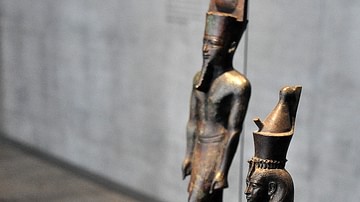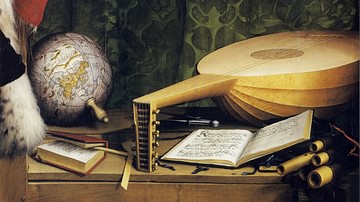On the evening of 30 May 1593, the sounds of a heated argument could be heard emanating from a boarding house in Deptford, a district of London on the south bank of the River Thames. Two of the boarders were quarreling over which of them should pay the bill – or ‘the reckoning’ – for the supper they had just finished. As the argument escalated, a dagger was suddenly and “maliciously” drawn and one of the men attacked the other, inflicting “two wounds on his head of the length of two inches, and of the depth of a quarter inch” (quoted in Wells, 99). The wound, though deep, was not fatal, but the wounded man now feared for his life. After a desperate struggle, he wrenched the dagger free from his attacker’s hands and gave his opponent “a mortal wound over his right eye” (ibid, 100). The attacker died instantly, according to the coroner’s report, although modern medical opinion holds that he likely lived for several minutes before succumbing to his injury.

The man who had lost his life in this apparently meaningless struggle was none other than Christopher ‘Kit’ Marlowe, the 29-year-old darling of Elizabethan theatre and poetry. Marlowe – who was about the same age as his great contemporary William Shakespeare, both born c. 1564 – had a polarizing reputation, one that led to varied reactions when news of his death spread throughout the city of London. Fellow poet George Peele lamented the loss of a literary genius, referring to Marlowe as “the darling of the muses” while Thomas Dekker imagined his soul in the Elysian Fields, resting in the shade of a large grapevine. Other contemporaries were not so sorry to hear about the loss of a man who was a notorious street brawler, atheist, and sodomite. Thomas Beard, referring to the blasphemous comments Marlowe was alleged to have made shortly before his death, was glad to “see what a hook the Lord put in the nostrils of this barking dog” (Cheney, 24). For Beard, it was hardly surprising that an unscrupulous fellow like Marlowe should meet his inglorious end in a barroom brawl.
Frizer’s Testimony
But was that truly the whole of the story? For centuries, the circumstances surrounding Marlowe’s death were shrouded in myth. Various stories abounded – from the implausible idea that he faked his own death and went on to write the plays of Shakespeare, to the more scandalous tale told by writer Francis Meres (l. 1565-1647), who alleges that Marlowe was “stabbed to death by a bawdy serving-man, a rival of his lewd love”, with ‘lewd love’ here referring to a prostitute (quoted in Wells, 62). The story recounted at the beginning of this article did not surface until 1925, when several legal documents relating to the killing were discovered by Elizabethan scholar Leslie Hotson. The documents were from a coroner’s inquiry conducted on 1 June 1593, only two days after the incident, and contain the detailed testimony of Ingram Frizer, the man who had quarreled with, and ultimately killed, Marlowe. According to Frizer, there had been four of them staying at the Deptford boarding house run by a widow named Eleanor Bull: these four guests included Frizer, Robert Poley, Nicholas Skeres, and Marlowe himself.
If Frizer’s testimony can be believed, the four men met at 10 am on the day of Marlowe’s death. They enjoyed a midday meal, during which they were “in quiet sort with one another” – presumed to mean they were getting along well – before taking a garden walk until 6 pm. After this walk came supper; according to the coroner’s inquiry, Marlowe was lying “on a bed in the room where they supped” while the other three men were sitting together, their backs toward the bed, Frizer sandwiched tightly between Poley and Skeres. Marlowe and Frizer argued over which of them would pay the bill before the poet became violent, seizing Frizer’s own dagger and attacking him. Frizer, stuck between the two other men, found that he “in no wise could take flight” and was forced to defend himself (quoted in Wells, 99). Frizer therefore claimed he had killed Marlowe purely in self-defense, a finding that the coroner’s inquiry agreed with, deciding that Frizer had indeed acted “in the defense and saving of his own life”. Marlowe was buried in a mass grave, and Frizer was granted a full royal pardon less than a month later. The case had been open-and-shut, a regrettable instance of a fight taken too far.
Or so it would seem. In fact, there are reasons to doubt that Frizer and his companions were being entirely truthful in their account of what happened. Frizer, Poley, and Skeres were all connected to the queen’s secret service – Frizer was the personal servant of the nephew of the queen’s spymaster, while Poley and Skeres were experienced agents who had helped uncover the 1586 Babington Plot to assassinate the queen. All three were known to be men of dubious character; Skeres, for instance, had a history of luring unsuspecting young men into money-lending schemes, while Poley had various connections to the criminals of London’s underworld and had once said he would rather perjure himself than say anything that would harm him. Frizer, of course, had every reason to lie, since he would be sentenced to death if convicted of murder. Thus, the testimony of this “profoundly slippery trio” – as Charles Nicholl calls them – should probably be taken with a grain of salt. What these men were doing meeting with Marlowe in the first place is unclear, although it may have had something to do with the poet’s own history – for Marlowe himself had worked for the queen’s secret service and may have even been a double agent.
Marlowe the Spy
The England of Marlowe’s day was a tumultuous place. In the words of scholar Russ McDonald, it was “a shadowy realm of religious intrigue, talk of treason, assassination attempts, and dirty tricks performed by the queen’s secret police” (1217). Queen Elizabeth I of England was surrounded by enemies on all sides; a Protestant, she had cracked down on Roman Catholicism after being excommunicated by the pope in 1570, opening her up to plots from dissident Catholics. One such conspiracy was the Babington Plot uncovered by Poley and Skeres, in which the conspirators had plotted to assassinate her so that the Catholic Mary, Queen of Scots could ascend the English throne. Seven of these conspirators, including the poet Chidiock Tichborne, were hanged, drawn, and quartered, a fate so gruesome that Elizabeth had to commute the sentences of the remaining conspirators to death by hanging, such was the public outcry. The childless queen also faced threats from would-be successors and from foreign powers such as Catholic Spain, whose great Spanish armada was narrowly smashed in 1588. It is therefore not difficult to see why she authorized her spymaster, Sir Francis Walsingham, to organize the first state-sponsored secret service in English history, to sniff out traitors and smother dissent in its cradle.
Marlowe was recruited into the service while still a student at Cambridge, sometime in the mid-1580s. Well-educated, literary men like him were judged as valuable assets, since they could read and carry messages. The details of Marlowe’s spying career remain murky, although he took multiple leaves of absence from Cambridge, likely to carry out his undercover work. These absences were so secretive that a rumor began to spread that Marlowe was a secret Catholic – it was known that subversive English Catholics went to the English seminary in Rheims, France, only to return as secret missionaries or to otherwise disrupt the queen’s government. In June 1587, the Queen’s Privy Council wrote a letter to Cambridge to dispel the rumors that Marlowe had gone to Rheims as a Catholic; indeed, the Council went so far as to assure the university that Marlowe had been doing “her majesty good service, and deserved to be rewarded for his faithful dealing” (quoted in Wells, 80). Amongst the letter’s signatories was the spymaster Walsingham, supporting the idea that Marlowe had been off working for his intricate spy network.
But although the Privy Council went through such pains to assure Cambridge that Marlowe was a loyal subject, it is still possible he acted as a double agent, at least on occasion. Scholar David Riggs writes: “The vast majority of secret agents toiled in a marginal and mercenary occupation. Their own employers held them in suspicion…field operatives rarely found posts in the civil service or the professions, and there is no reason to believe that Marlowe’s prospects were any different” (Cheney, 30). It is also worth noting that, in late 1589, Marlowe befriended John Poole, a gentleman with Catholic sympathies who had ties to England’s Catholic underground. Around the same time, Marlowe also became associated with Poole’s relative, Ferdinando Stanley, Lord Strange, who – after the execution of Mary, Queen of Scots – became the figurehead that English Catholics rallied around in the hope of reclaiming the throne.
Marlowe wrote for Lord Strange’s acting company, who performed some of his most famous plays. While this did not necessarily mean that Marlowe supported Strange’s claim to the throne – other famous writers like Edmund Spenser and William Shakespeare were also patronized by Strange – he took pride in mentioning his connections to Strange and the Earl of Northumberland, another suspected leader in Catholic conspiracies. In early 1592, Marlowe was implicated in a counterfeiting scheme that Sir Robert Sidney believed was part of a larger plot to advance Strange’s claim. It is important to note that Marlowe was never charged in the counterfeiting scheme, meaning that it may conceivably have been part of his work for the queen’s secret service. Whatever the true nature of Marlowe’s loyalties, he was deeply involved in a web of political intrigue, the details of which will likely never be fully known.
Charges of Blasphemy and Arrest
At a time when religious issues were of utmost importance, comments that could be considered blasphemous were taken quite seriously. As a playwright, Marlowe certainly straddled this line – his famous work Tamburlaine the Great was judged to be atheistic by fellow poet Robert Greene, while some of his other plays were accused of having anti-Christian elements. Marlowe himself was known to have led something of a hedonistic lifestyle, having once apparently said that all men who did not love “tobacco and boys” were fools. All this would prove troublesome for him when, on 5 May 1593, several bills were posted around London threatening Protestant refugees who had come from France and the Netherlands. The posts were written in iambic pentameter, were signed ‘Tamburlaine’, and made several other references to the works of Marlowe. The Queen’s Privy Council naturally took these anti-Protestant posts seriously and, on 11 May, ordered the arrests of those suspected of writing them.

One of the men taken in for questioning was Thomas Kyd. A famous dramatist in his own right, Kyd had recently shared a room with Marlowe; when a three-page heretical tract was found in his lodging, Kyd claimed that it was not his but Marlowe’s, that it had been accidentally mixed in with his own papers when they parted ways. Kyd was then threatened with – or perhaps even subjected to – bodily torture, leading him to reveal the “heretical conceits” Marlowe had apparently made. According to Kyd, Marlowe was accustomed to “jest at the divine scriptures [and] gibe at prayers” and that he had often argued that Jesus Christ had been in a homosexual relationship with Saint John (Cheney, 36). Whether Marlowe had ever made such comments is unknown, as Kyd was under extreme duress when he accused him of making them. Nevertheless, a warrant was issued for Marlowe’s arrest and he presented himself to the Privy Council on 20 May 1593. Marlowe was not imprisoned, as it was understood that he would present himself to the Council daily until such a time as a trial could be held. But of course, Marlowe was killed only ten days after his arrest, leading many to wonder whether this incident had anything to do with his death.
Why Was Marlowe Really Killed?
So, all this naturally raises the question – assuming Frizer’s testimony is fake or embellished, why was Marlowe really killed? It must be stressed that this question cannot be answered with any certainty, as much of the evidence has likely been lost to history; what follows are educated speculations at best and conspiracy theories at worst. Considering the connections of all four men to the queen’s secret service, it is tempting to suggest that Marlowe’s death was government sanctioned – whether it was signed off by the queen herself or someone on the Privy Council is anyone’s guess. Perhaps the queen, concerned about Marlowe’s subversive and atheistic writings, had him killed before he could cause any lasting trouble. But this seems unnecessary – surely it would have been easier for the government to wait until Marlowe’s trial and likely execution rather than go through the trouble of a secret assassination?
Another suggestion is that Marlowe was killed on the orders of someone worried about what he might reveal at his trial. Just as Kyd had given up Marlowe under torture, it is not inconceivable to think that Marlowe might have revealed that certain powerful figures were secret atheists; indeed, Marlowe had connections to the so-called ‘School of Night’, a circle of freethinkers associated with Sir Walter Raleigh who were rumored to be involved in atheism, heresy, and even black magic. It has also been speculated that the killing may have been more personal in motive – perhaps Marlowe simply owed Poley and Skeres money, and their shakedown went a bit too far. And, of course, there is the wild speculation that Marlowe faked his death in order to avoid his upcoming trial and execution; with his connections to the Walsinghams and the secret service, this is not impossible, though highly unlikely. The idea that he went on to write Shakespeare’s plays but allowed his rival poet from Stratford-upon-Avon to reap the credit is also quite out of character. In the end, we will probably never know what truly took place at Deptford on that fateful May evening. All that can be said for certain is that one of the greatest and most colorful poets of the Elizabethan Era lost his life, marking an abrupt end to a remarkable career.









